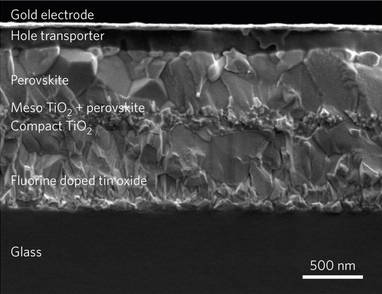Using AI to control energy for indoor agriculture
30 September 2024
Published online 20 January 2016
New material improves state-of-the-art solar cells.

Nazeeruddin/Nature Energy
Perovskite-based solar cells are one of the most promising solar technologies and have seen a rapid improvement in efficiency in recent years. While perovskite is inexpensive, the hole-transport material used in the cells, spiro-OMeTAD, is extremely expensive.
Now, researchers developed and tested a new hole-transport material, FDT, and used it to reach an efficiency of 20.2%, comparable with the best spiro-OMeTAD cells. FDT costs roughly a fifth as much as spiro-OMeTAD, and is easier to synthesize.
FDT can also be dissolved in toluene, which is more environmentally friendly than the chlorobenzene used for spiro-OMeTAD.
“We’ve been working with spiro-OMeTAD for the last 20 years and its efficiency has peaked, whereas we’ve just started with FDT. We hope to reach yet higher efficiencies while remaining cost effective,” says Mohammad Khaja Nazeeruddin of Switzerland’s EPFL. “We’ve already replaced spiro-OMeTAD with FDT in our lab.”
The team is now testing the long-term stability of FDT-based perovskite solar cells in cooperation with Spain’s Abengoa. “If its stability is proven, the impact will be enormous for applications ranging from solar cells to sensing, imaging, environment and optoelectronics,” says Nazeeruddin.
doi:10.1038/nmiddleeast.2016.4
Saliba, M. et al. A molecularly engineered hole-transporting material for efficient perovskite solar cells. Nature Energy http://dx.doi.org/10.1038/nenergy.2015.17 (2016).
Stay connected: